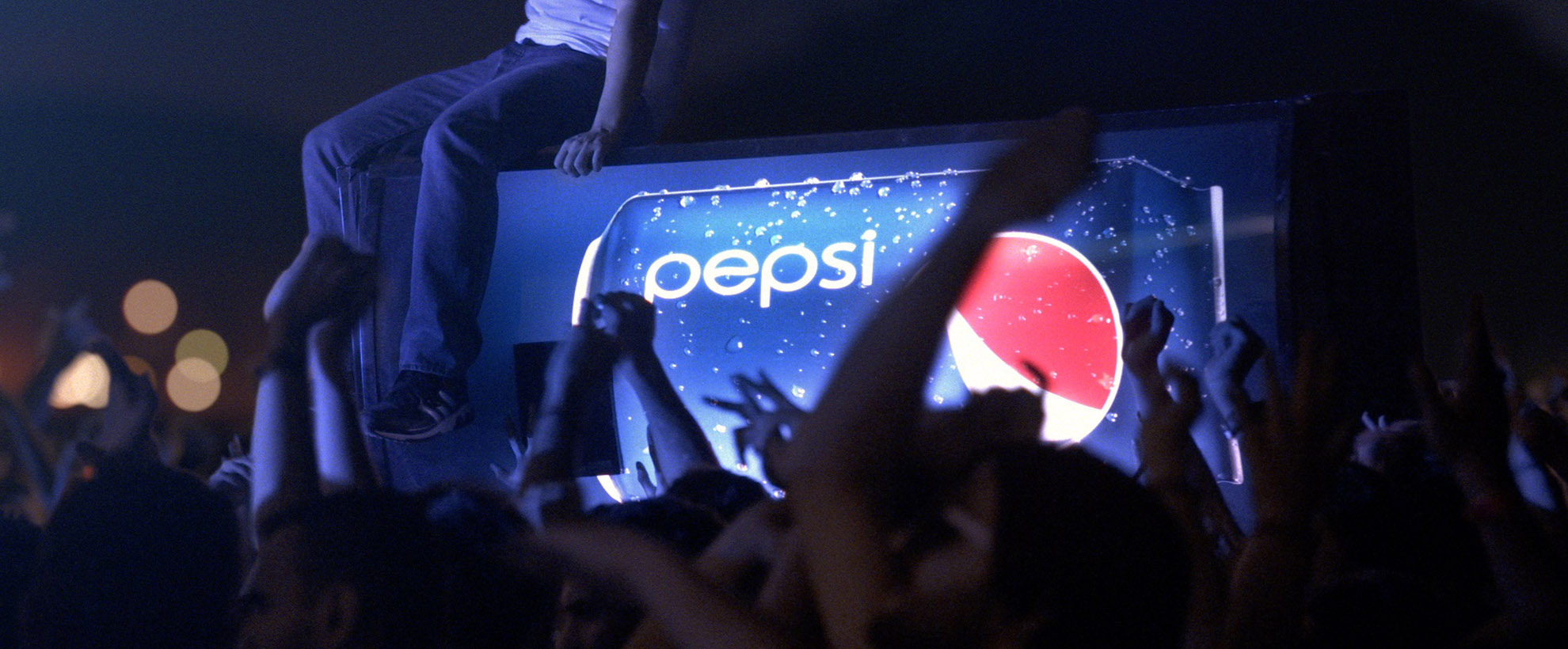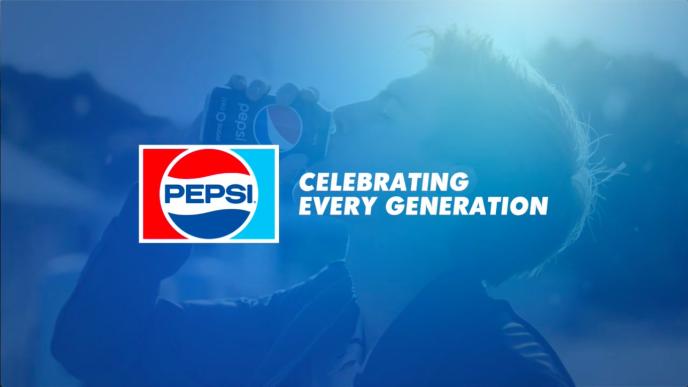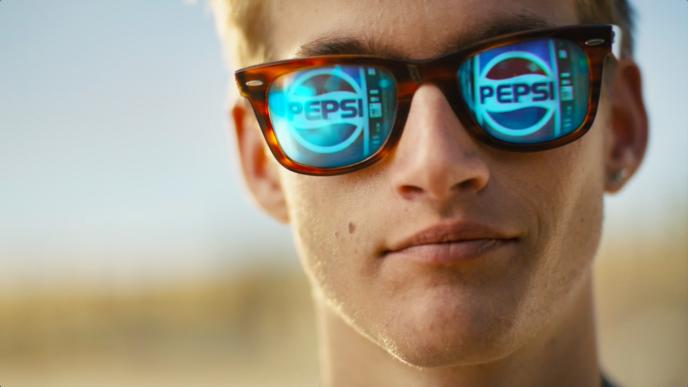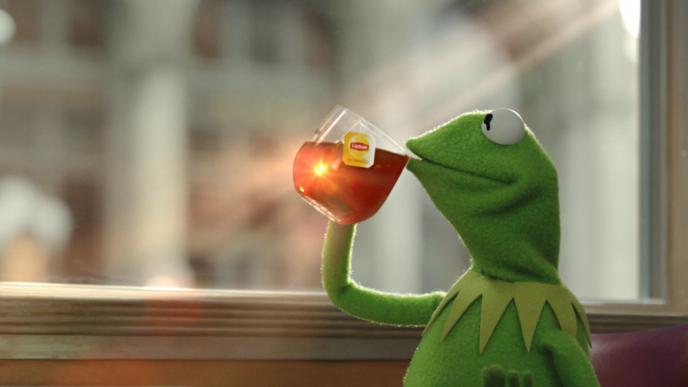
Pepsi
Pop a bottle (of Pepsi, that is) and take in just some of the award-winning VFX work created by Framestore for the soda giant.

Beyoncé 'Mirrors', 2013
Framestore teamed with 180 LA and Pepsi on an advertising campaign featuring Beyoncé, titled 'Mirrors'. The spot celebrates Beyoncé’s most iconic personalities from her past – including Sasha Fierce, and the singer as we saw her in Bootylicious and Crazy in Love – as well as her iconic dance moves and unforgettable fashion, flashing before her in a mirror as she dances through her past step-for-step.
The choreography builds to a climactic ending as Beyoncé shakes out of her reflective mood and breaks back into the present – a move manifested by the mirrors around her shattering into millions of pieces.
'Mirrors' was the first effort to come out of Framestore's LA studio, created in cooperation with the company's London office. 180 LA approached the VFX company early on in the process, sharing a fantastic idea that would allow Pepsi and Beyoncé to explore a rich history of colourful characters. That being said, they needed a methodology that would allow them to use historic footage of the star in the mirrors surrounding her on the sound stage.


180 LA's creative concept was brought to life by Framestore's meticulous technical execution. Inserting historic footage of Beyoncé inside the mirrors required significant planning, and the Framestore CG team used photogrammetry/photo-modelling and survey techniques coupled with global illumination rendering to create the studio replica and images.
'The mirrors in the studio added a huge layer of complexity', said Aron Hjartarson, Framestore Creative Director. 'Since each mirror required a separate plate, the VFX shooting demands were extremely high. Beyoncé and Pepsi are icons and the expectations were immense – we’re lucky that we’re able to access such top notch talent within our network of studios around the globe.'
Oscar-winning cinematographer Claudio Miranda shot the master plates of modern Beyoncé using a motion control rig to capture the best imaging. The smashing of the mirrors was simulated using Houdini rigid body dynamics and particle systems.
'Framestore was involved from an early point in the process, allowing us to establish a creative pre-visualization plan with the agency, editor Steve Gandolfi and director Jake Nava', explained Alex Thomas, Framestore's Head of 2D/ VFX Supervisor. 'Working on a project of this scale has been a brilliant, collaborative experience, and a really exciting way to launch the LA office.'

'Crowd Surfing', 2012
Framestore completed VFX work on an epic Pepsi commercial that sees San Sebastian's beach play host to a massive party, with DJ Calvin Harris at the helm. But the star power doesn't end there! Also at the party are world class footballers - Aguero, Drogba, Lampard, Messi, Torres and Wilshere - who indulge in a game of football above the crowd whilst supported by thousands of partygoers.
Framestore's team of 20 VFX artists - spanning crowd specialists, Nuke compositors, roto artists, animators and technical directors - worked across the production for four months in order to deliver the commercial's demanding and complex VFX, whilst meeting all clients' high expectations. In the words of David Foulds, PepsiCo International's Vice President Advertising: 'To say that we are delighted with the final product would be an understatement.'
Framestore created a new proprietary crowd system in order to fulfil the commercial's massive scale. The system, developed by Diarmid Harrison-Murray and Martin Aufinger, was built in Houdini using mo-cap data captured at Framestore's in-house motion capture facility.
The crowd system is specifically designed to meet the needs of commercial projects. It allows a more efficient shot turnaround and gives the artist greater control over the crowds' behaviour and look, down to details such as outfit, hairstyle, props and more. Using Houdini's native renderer, Mantra, allowed artists to set up agents quicker and use more complex lighting techniques on selected parts of the crowd whilst still being able to render thousands of background people within the same setup.
Framestore's new crowd system allows shots to be laid out quickly using an instancing approach, without having to simulate each agent separately. This meant VFX artists could show the director many iterations of the crowd layout in a relatively short amount of time.
Once the rough layout is approved, it is then possible to split off parts of the crowd that require bespoke behaviours, adding more layers of sophistication, in this case taking it to a level of detail where hands could dynamically grab footballers' feet and even hold flashing camera phones. This custom-built system became invaluable for creating realistic looking scenes.
As Aufinger explains: 'The fun part of a crowd job is when you suddenly notice unusually strange, almost disturbing behaviour of one or two agents of a CG crowd. Luckily, we were easily able to quickly eliminate those offending agents!'
By merging the ability to lay out a crowd quickly with a technique that enables pinpointing of individual sections for more bespoke animation, the end results look utterly authentic and have been created with an efficiency that gave Framestore's team more time to focus on improving more relevant parts of shots, thus freeing them from waiting for time-consuming simulations.
One key advantage of this approach over shooting live action crowd plates is that the lighting and atmosphere enveloping the crowd could be altered at any stage of the post process. As a result, this system has now become Framestore's de-facto crowd system for commercial projects and several other departments have already shown great interest in using it. The modular nature of the system means that additional features can be easily added as future projects require.
The project also gave Framestore's 2D team - led by Chris Redding and Russell Dodgson - an interesting array of challenges. A small scale crew visited San Sebastian early in the process to capture very high resolution panoramic 'dome' images of the San Sebastian beach and to shoot the wide opening shot. These high-res location images were then projected onto an accurate topographical model of San Sebastian, extracted from Google Earth. This allowed the team to place a virtual camera anywhere on the beach and achieve realistic scale, perspective and defocus effects, which led to a huge degree of efficiency and consistency across the whole spot.
Due to the limited availability of the hero footballers, the live action elements were spread across three shoots in three different countries, supervised by Chris Redding. Most of the live action crowd elements, body doubles, Calvin Harris and his DJ stage were shot over six days in Romania. The hero players, with the exception of Messi, were shot at Shepperton Studios in England, with Messi being filmed later in Barcelona.
In order to achieve the best result in matching live action elements and CG crowd, the animation team roto-animated the footballers' performances to be able to relight them in 3D. This approach also provided the freedom to create more dramatic lighting effects and make sure the heroes of the commercial stood out from the supporting crowd.
Another team were tasked with developing the lazer letters that spell out the players' names as they race across the crowd. After an initial brief from the director that referenced some prototype Japanese ionising lazers, a small team began testing several approaches. Using Houdini once again, the team quickly reached the aesthetic solution seen in the finished spot.
A further team, this time using Autodesk Maya, handled a wide range of additional duties. These included creating the upper two thirds of the main stage, including rigging, moving light units, background cars, additional volumetric lights and even full CG face replacements for some of the hero players. The Maya team was also responsible for creating fully CG digi doubles to replace almost all live action footballer body doubles in wider shots.

'Rising', 2009
Pepsi 'Rising' features a young man scaling a mountain of objects, both literal and metaphorical, as he pursues his dream. Directed by Daniel Kleinman for Rattling Stick, and created by CLM-BBDO, the spot's spectacular visuals were devised and implemented by a Framestore team led by long-time Kleinman collaborator, William Bartlett.
The initial elements were captured over a five day shoot at Pinewood, with further material for the landscape backgrounds captured by Bartlett during a couple of days in Dartmoor, one on the ground, one in a Microlight. 'We felt that the more bits where the actor is touching and connected with real objects, the better', says Bartlett, 'So the dartboard, the spokes and rim of the bike wheel, the neck of the guitar and its 'strings' - all those were real giant models. Also shot for real were the various real world environments - the fast food counter, the school, the parental home, the business floor. In each of those we also shot two passes, so we could create the effect of two different gravitational fields at work - one for the rooms and their inhabitants and another for the external 'reality', ie the steep surface our hero is climbing.'
Nonetheless, an enormous quantity of material remained to be added in post - some 300 objects in all. Says Bartlett, 'Because so much needed to be added, we started with the edit and then gradually added all the elements. The geography of the set and a sense of height and scale - all the layout stuff was done in Flame, where we first tracked all the shots. The 3D team made low-res versions of many of the objects, which I'd take into Flame and block it all out and get it approved in grey scale. Then we would export it into 3D to set up, and then ultimately render it all - an intimidating volume of stuff.'
Bartlett's counterpart in 3D was Simon French, who led up to 10 people over an incredibly intensive two month period. French spent a lot of his initial time on an asset management system, creating a set of discreet, re-usable assets. The 3D team was split into a Houdini team, handling the hundreds of background objects, and a Maya team, creating the 'hero' objects. 'It was an interesting job', reflects French, 'Just in terms of seeing how far we could push the necessary integration of these two packages.'
The complexity of the job - the enormous number of assets and the dual use of Maya and Houdini - meant that the team developed something more akin to a movie pipeline than something entailed by the average commercial. This enabled the lighting TDs to build scenes quickly and to devote their attention to making the shots look good, rather than the repetitive work of placing models and assigning shaders. Says Producer Michael Stanish, '"Rising" was a brilliant use of existing techniques to striking effect, and it looks fantastic. But on a purely technical level, the asset management system was the project's most remarkable achievement, and it's one that will stand us in good stead in the future.'

'Flight of the Penguin', 2009
Our hero comes in an unlikely form in 'Flight of the Penguin', featuring VFX and CGI from Framestore. 'Gunnar' stars as an ambitious penguin who marches to the beat of his own drum. Despite the fact that his dream of flying is hampered by his physical body, our hero penguin will not be deterred. This feel good spot was produced for client BBDO and directed by Traktor, both frequent collaborators with Framestore.
The spot opens on the hapless penguin trying to mimic the ability to fly that he witnesses in the seagulls that share his arctic lagoon. After many pathetic attempts that have him face-planting into the thick snow, the penguin realizes that his penguin wings will not allow for natural flight and he heads to his isolated workshop to build his own flying machine. After many hours of hard work the penguin emerges victorious with a homemade jet-pack strapped to his back. The overcast skies clear and, as his earthbound penguin friends look on, our hero shoots across the sunny sky and lands in a poolside chaise longue alongside a bikini-clad woman to enjoy some fish and, the ultimate hero reward, a bottle of Pepsi.
'We wanted to make the penguin as likeable as possible because we needed the viewers to be emotionally attached to him and to cheer when he succeeds in achieving his dream', said Murray Butler, Senior Flame Artist at Framestore.
'Our goal was to make sure that the penguin was not too cartoonish', said lead CG Artist, Andy Walker. 'So we spent a lot of time working on the movements of the penguin to make sure that they were natural, not exaggerated.'
Another challenge for the Framestore team was to recreate the look and feel of snow piling up as the penguin repeatedly nose dives into it during his failed attempts at flight.
'We actually took bean bags to the lagoon in Iceland where we shot the scenery. We threw the bean bags into the snow so that we could capture on film the way that the snow piled up when something hit it', said Butler. 'We were able to combine these live action elements with some CGI snow enhancement to create very authentic interaction between our Penguin and the snow around him.'
While the landscape shots of the lagoon were filmed in Iceland, the poolside shots, suitably, were filmed in Los Angeles on location. The hut and seagulls were shot in a studio. Additionally, Traktor traveled to a penguin sanctuary in Texas to film the live-action penguins that mix and mingle with the many CGI penguins that were created at Framestore.
The weather was an important metaphor in this spot; a miserable and overcast sky hangs over the lead penguin's head as he fails at his attempts to fly, but when he emerges from his workshop victorious, the sun lights him up and makes him heroic, and he takes flight. A lot of VFX magic was used to build the sky and atmosphere and the dramatic changes add to the tension of the story.
This beautiful 60 second spot about somebody trying to fulfill their dreams, despite their limitations, debuted in Europe and later rolled out to other regions worldwide.

'Sumo', 2005
Framestore Plays Chicken with Pepsi
What happens when you cross a bottle of Pepsi and two roasted chickens? Answer: a wrestling match in Framestore and BBDO's 30 spot for Pepsi entitled Sumo.
'The challenge was trying to make realistic, edible chickens, while giving the animators freedom to move the chickens however they liked, well beyond the movement a real chicken can achieve', said Andy Walker, 3D Animator, Framestore. 'All areas needed to be strong with a robust character setup, complex shaders to make it look succulen,t and animation with the right balance of humor, weight and realism.'
'Sumo' opens with a young man toting a two litre bottle of Pepsi into a convenience store to buy himself a roasted chicken. After the cashier asks him which of the two chickens he would prefer, the man bends down to get a closer look at the golden brown birds in the deli showcase. When the chickens feel his presence and catch a glimpse of his Pepsi bottle, the spot quickly turns into a bizarre lesson in survival of the fittest. The two chickens suddenly pop up and begin to sumo wrestle as the young man watches in awe. Unfazed, the cashier provides occasional commentary. 'Sumo' ends with one chicken being thrown out of the display case and the victorious chicken is awarded the honor of being tonight's dinner.
Framestore used a standard 3D Maya/Mental Ray pipeline as well as a large selection of in house tools created during their long experience in creature and character work for film, television and commercials. Proprietary skinning and dynamic muscle systems helped to hold the shape of the chicken character as well as allow efficient character design changes.
'The entire fight was planned prior to the shoot', said Murray Butler, VFX Supervisor, Framestore. 'Using footage we shot of actual sumo wrestlers, the director was able to cut an entire sequence and even decide on general angles for each shot. The fight footage was then adapted to work with the CGI chickens we built. We shot real roasted chickens in position for reflections, shadows and general look reference. We also made sure we shot real focus pulls and glass reflection passes to ensure that our effects looked as optical as possible.'

Press
Ad of the Day: Pepsi - Adweek
Pepsi gets four Beyoncé's for the price of one - The Drum
Relive Beyoncé's Best Fashion Moments Through Her New Pepsi Commercial - Fashionista
Beyoncé’s ‘Mirrors’: #BeyHereNow Announcement Is A Pepsi Ad - The Huffington Post
Pepsi Max unveils global Beyoncé campaign - Marketing Magazine


